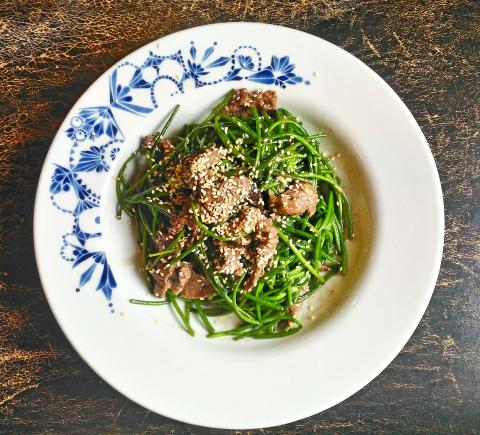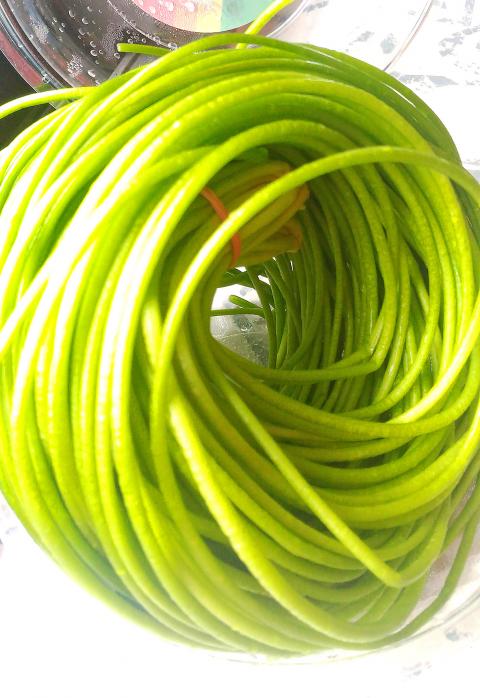Usually sold in coils resembling thick green electrical wire, white water snowflake (水蓮菜) is an easy-to-prepare vegetable that is relatively common in Taiwan, but which is rarely seen elsewhere. Most English information regarding this plant relates to its use in ornamental water gardens. It is almost entirely unrecognized as a food outside of Taiwan, which is surprising as it has a pleasant flavor and it is almost ludicrously easy to prepare.
The name “white water snowflake” refers to the delicate white flowers that make this plant such an asset in enhancing a household water feature. It is also sometimes referred to as crested floating heart. Both these names are remarkably misleading as a name for the vegetable. The part of the white water snowflake that is eaten is the stem of the plant, long tendrils sometimes more than a meter in length. These are usually bundled into a coil for sale.
White water snowflake was once a regular feature of the southern Taiwan landscape, readily found in ponds and near irrigation canals, but have virtually disappeared now due to the many types of pollution that have swept over a once pristine agricultural landscape, particularly the rapid growth in fish farming, that has made most waterways far too toxic for this delicate plant. It is now cultivated specifically for the table, particularly in the area around Kaohsiung’s Meinung District (美濃), where it has become a specialty of the local cuisine.

Photo: Ian Bartholomew
That white water snowflake has not gained wider traction in Taiwan’s culinary world is a matter of some bewilderment to me, for unlike some of the more unusual vegetables I have covered in this column, such as birds nest fern (山蘇), fiddlehead fern (過貓), ercai (兒菜, a relative of the mustard green) and others, it does not feature unusual textures or flavors, nor does it have a bizarre or intimidating appearance. The stem, the part of the white water snowflake we are interested in for culinary purposes, is a vascular bundle designed as a transport system for the plant’s nutrients. This gives it a nice crisp texture despite its small diameter.
For people in a hurry, white water snowflake has the distinct advantage of being decidedly one of those “less is more” vegetables in regard to preparation, and even on its home turf in Meinung, the range of its applications is mostly limited to a quick toss in a hot wok and the addition of meat, mushrooms or veg. There are few recipes that go much beyond a little heat and a little liquid, stir vigorously and serve.
Don’t let the lack of culinary complexity in the use of white water snowflake lead you to dismiss it as uninteresting. Certainly its flavor is very delicate, and care should be taken not to over season. The plant is also packed full of all kinds of good things on the nutritional front. It is referred to as the “king of zinc” of the vegetable world for its high content of that mineral, and is also a good source of vitamin B12. It’s greatest claim to fame in various Chinese nutritional sources is the presence of abundant glycosaminoglycans, which, putting aside all the scientific jargon, are supposed to help keep us looking and feeling young. That’s pretty impressive when you consider that a big bunch of white water snowflake will put you back around NT$50, which is vastly cheaper than the many varieties of youth-preserving snake oils marketed by the cosmetics industry.

Photo: Ian Bartholomew
Stir fried white water snowflake in sesame oil with beef tenderloin
Recipe (Serves 2)
White water snowflake is easy to prepare and can be very delicious. The trick is speed and a light touch with the flavorings. Simply tossing it into a wok with some wood ear fungus and garlic is quite enough to turn out a tasty side dish, and the flavor of the dish can be tarted up with fermented bean paste or kaoliang wine. After many variations, I have found that the combination of ginger, sesame oil and beef works best, providing a assertive background that still allows the vegetable space to express itself.
Ingredients
200g white water snowflake, cut into 5cm lengths
200g beef tenderloin, finely sliced (shredded pork also works)
5 dried Chinese mushrooms
1 small nub of ginger, minced
1 tablespoon soy sauce
1 teaspoon corn starch
1 tablespoon dark sesame oil
1 tablespoon vegetable oil
Quarter cup vegetable stock, or water
Large pinch white pepper
Salt to season
Sprinkling of white sesame seeds
Directions
1. Marinate the beef in soy and corn starch for about 10 minutes.
2. Soak the Chinese mushrooms in boiling water and cover for about five minutes. Remove, cut away the stem and slice.
3. Heat the vegetable oil and fry the ginger on medium heat until fragrant.
4. Add the marinated beef. Allow to sear for 30 seconds. Add sesame oil, sliced mushrooms and stir.
5. Add the white water snowflake, season with salt and white pepper. Add stock and turn heat to high.
6. Allow the liquid to evaporate and taste for seasoning.
7. Serve with a sprinkling of sesame seeds.
Ian Bartholomew runs Ian’s Table, a small guesthouse in Hualien. He has lived in Taiwan for many years writing about the food scene and has decided that until you look at farming, you know nothing about the food you eat. He can be contacted at Hualien202@gmail.com.

May 18 to May 24 Pastor Yang Hsu’s (楊煦) congregation was shocked upon seeing the land he chose to build his orphanage. It was surrounded by mountains on three sides, and the only way to access it was to cross a river by foot. The soil was poor due to runoff, and large rocks strewn across the plot prevented much from growing. In addition, there was no running water or electricity. But it was all Yang could afford. He and his Indigenous Atayal wife Lin Feng-ying (林鳳英) had already been caring for 24 orphans in their home, and they were in

On May 2, Chinese Nationalist Party (KMT) Chairman Eric Chu (朱立倫), at a meeting in support of Taipei city councilors at party headquarters, compared President William Lai (賴清德) to Hitler. Chu claimed that unlike any other democracy worldwide in history, no other leader was rooting out opposing parties like Lai and the Democratic Progressive Party (DPP). That his statements are wildly inaccurate was not the point. It was a rallying cry, not a history lesson. This was intentional to provoke the international diplomatic community into a response, which was promptly provided. Both the German and Israeli offices issued statements on Facebook

Even by the standards of Ukraine’s International Legion, which comprises volunteers from over 55 countries, Han has an unusual backstory. Born in Taichung, he grew up in Costa Rica — then one of Taiwan’s diplomatic allies — where a relative worked for the embassy. After attending an American international high school in San Jose, Costa Rica’s capital, Han — who prefers to use only his given name for OPSEC (operations security) reasons — moved to the US in his teens. He attended Penn State University before returning to Taiwan to work in the semiconductor industry in Kaohsiung, where he

Australia’s ABC last week published a piece on the recall campaign. The article emphasized the divisions in Taiwanese society and blamed the recall for worsening them. It quotes a supporter of the Taiwan People’s Party (TPP) as saying “I’m 43 years old, born and raised here, and I’ve never seen the country this divided in my entire life.” Apparently, as an adult, she slept through the post-election violence in 2000 and 2004 by the Chinese Nationalist Party (KMT), the veiled coup threats by the military when Chen Shui-bian (陳水扁) became president, the 2006 Red Shirt protests against him ginned up by